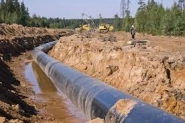 A thesis submitted in Department of Chemical and Materials Engineering University of Alberta, © Zeynab Shirband, 2016.
A thesis submitted in Department of Chemical and Materials Engineering University of Alberta, © Zeynab Shirband, 2016.
Near-neutral pH stress corrosion cracks (NNpH SCC) are developed under coating disbondments on the external surface of pipelines where the surface of pipeline is exposed to the soil solution. NNpH SCC initiation and early stage of growth is mainly governed by the dissolution process of steel. …This study aimed at understanding the contribution of these important factors to NNpH SCC. In this study, the role of coating disbondment on hydrogen ingress into pipeline steels and the effects of mill-scale and hydrotesting on NNpH SCC crack initiation are investigated.

 An interesting paper in
An interesting paper in 

 A new
A new 
 This paper present a failure analysis of box-like link-plate. The failed link-plate is fabricated from 42CrMo steel and the surface of internal hole is demanded to be induction-hardened.
This paper present a failure analysis of box-like link-plate. The failed link-plate is fabricated from 42CrMo steel and the surface of internal hole is demanded to be induction-hardened.